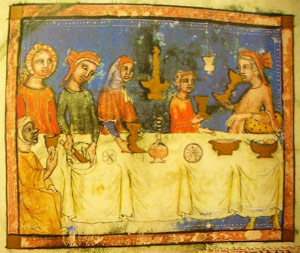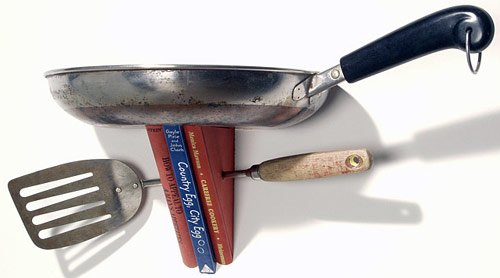Yum… Typolade makes letters out of chocolate.
 I have a friend who I can count on to know the meaning of any word thrown at her. But to my surprise, I recently stumped her with “interobang.” An interobang is a little used punctuation mark combining a question mark (also called the interrogative point) and an exclamation mark (which typesetters refer to as a bang). That’s it to the right. It was introduced in 1962 by Martin K. Speckter as a short hand punctuation for statements where neither mark alone exactly served the writer (as in “She said what?!”) As a silly extension, the reverse and upside down interrobang (combining ¿ and ¡), suitable for starting phrases in Spanish, is called a gnaborretni (interrobang backwards).
I have a friend who I can count on to know the meaning of any word thrown at her. But to my surprise, I recently stumped her with “interobang.” An interobang is a little used punctuation mark combining a question mark (also called the interrogative point) and an exclamation mark (which typesetters refer to as a bang). That’s it to the right. It was introduced in 1962 by Martin K. Speckter as a short hand punctuation for statements where neither mark alone exactly served the writer (as in “She said what?!”) As a silly extension, the reverse and upside down interrobang (combining ¿ and ¡), suitable for starting phrases in Spanish, is called a gnaborretni (interrobang backwards).
An elegantly simple popup book by Marion Bataille, a graphic and book designer who lives in Paris. The video shows a hand-made mock-up of the actual book to be published in Oct. 2008. [update: It’s now available here]
 This week I read Geraldine Brooks’ new novel People of the Book, an imagined history of a real book, the Sarajevo Haggadah, the oldest surviving Jewish illuminated manuscript, which contains the traditional text that accompanies the Passover Seder.
This week I read Geraldine Brooks’ new novel People of the Book, an imagined history of a real book, the Sarajevo Haggadah, the oldest surviving Jewish illuminated manuscript, which contains the traditional text that accompanies the Passover Seder.
![]() The history of the book is largely unknown — it’s believed to have been made in Spain some time in the mid-14th century, during the Convivencia, when Christians, Muslims, and Jews lived together in relative peace. The Jews were expelled from Spain in 1492, and nothing more is known of the book until the 1500’s, when notes in the margin indicate that it surfaced in Venice and was saved from the book burnings of the Inquisition. It made its way to Vienna and in 1894 it was sold to the National Museum in Sarajevo. However that didn’t assure its survival — during World War II it was smuggled out of the Museum by a Muslim scholar and during the Bosnian War of the 1990’s it was again saved by a Muslim and hidden inside a bank vault.
The history of the book is largely unknown — it’s believed to have been made in Spain some time in the mid-14th century, during the Convivencia, when Christians, Muslims, and Jews lived together in relative peace. The Jews were expelled from Spain in 1492, and nothing more is known of the book until the 1500’s, when notes in the margin indicate that it surfaced in Venice and was saved from the book burnings of the Inquisition. It made its way to Vienna and in 1894 it was sold to the National Museum in Sarajevo. However that didn’t assure its survival — during World War II it was smuggled out of the Museum by a Muslim scholar and during the Bosnian War of the 1990’s it was again saved by a Muslim and hidden inside a bank vault.
![]() The plot of the book traces the fictional history of the Haggadah by traveling forwards and backwards in place and time. In the present day, Hanna Heath, an Australian book restorer, goes to Sarajevo to do restoration and conservation on the book before it is put on display. As part of her conservation efforts, she tries to ascertain more about the book’s history. In parallel, the reader learns about the book’s travels and owners as it journeys back in time across Europe.
The plot of the book traces the fictional history of the Haggadah by traveling forwards and backwards in place and time. In the present day, Hanna Heath, an Australian book restorer, goes to Sarajevo to do restoration and conservation on the book before it is put on display. As part of her conservation efforts, she tries to ascertain more about the book’s history. In parallel, the reader learns about the book’s travels and owners as it journeys back in time across Europe.
![]() I am amazed by the amount of research that Brooks must have done to write her book. There’s lots of information about bookbinding and conservation, as well as an incredible amount of historical detail. The adventures of the main, present-day narrator, Hanna, are awfully contrived, but the interspersed stories imagining the history of the Haggadah are much better. Certainly reading it was a fine way to spend a lazy Saturday afternoon!
I am amazed by the amount of research that Brooks must have done to write her book. There’s lots of information about bookbinding and conservation, as well as an incredible amount of historical detail. The adventures of the main, present-day narrator, Hanna, are awfully contrived, but the interspersed stories imagining the history of the Haggadah are much better. Certainly reading it was a fine way to spend a lazy Saturday afternoon!
Upcycling, taking something that is disposable and transforming it into something of greater use and value, has become a popular pastime among crafters. And noone makes a more creative use of something that gets discarded with abandon (books) than the shelves and “book art” made by Jim Rosenau. And on top of that, his web site is witty and full of great photos of his work! Here are 2 of my favorites, Pandemonium and Eat Fat:

Pi (π) is the symbol for the ratio of the circumference of a circle to its diameter. Pi is celebrated every year by math enthusiasts around the world today, March 14th.
![]() And what does Pi have to do with book arts or letterpress or type, you might ask? The first book I printed letterpress was a small artist’s book with Wislawa Szymborska‘s whimsical poem “Pi,” which juxtaposes the finite, impermanent world with the familiar never-ending sequence 3.1415926535… In my book, the first 200 or so digits of Pi dance across the pages, starting on the cover and skating off the back.
And what does Pi have to do with book arts or letterpress or type, you might ask? The first book I printed letterpress was a small artist’s book with Wislawa Szymborska‘s whimsical poem “Pi,” which juxtaposes the finite, impermanent world with the familiar never-ending sequence 3.1415926535… In my book, the first 200 or so digits of Pi dance across the pages, starting on the cover and skating off the back.
![]() So today, a toast to numbers and letterpress! You can read Szymborska’s poem, which begins “The admirable number pi: three point one four one.“, here. There’s an official (!) web site for Pi day with all sorts of fun facts and quotes and pointers to YouTube videos. And here’s a link to my book. I’ll finish off with this haiku from the PI Day web site:
So today, a toast to numbers and letterpress! You can read Szymborska’s poem, which begins “The admirable number pi: three point one four one.“, here. There’s an official (!) web site for Pi day with all sorts of fun facts and quotes and pointers to YouTube videos. And here’s a link to my book. I’ll finish off with this haiku from the PI Day web site:
![]() Three point one
Three point one
![]() Four
Four
![]() et cetera
et cetera